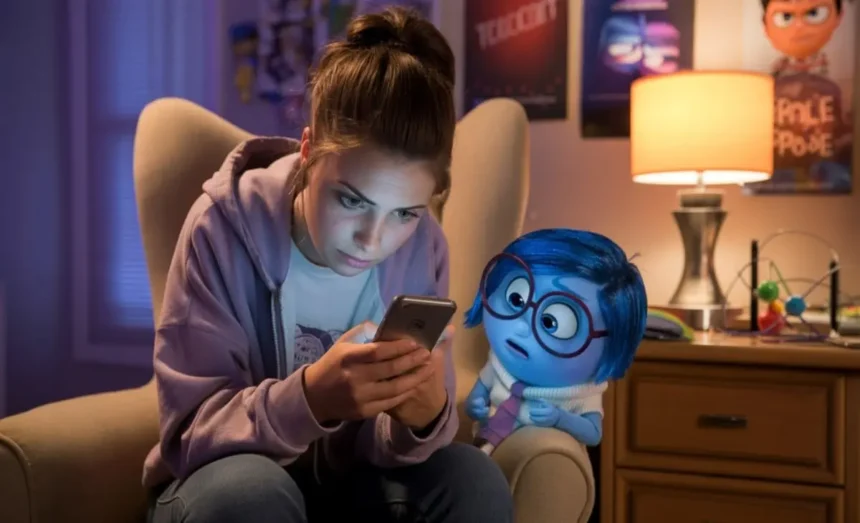Inside Out 2 Glued to Phoneis celebrated for its nuanced take on teenage emotions, not just the classics like joy or fear, but new layers of anxiety, envy, embarrassment, and ennui. Among its most thought-provoking moments is a fleeting scene often described as “glued to phone,” where Ennui, overwhelmed and disengaged, retreats into her smartphone. This gesture resonates deeply because it reflects a common, almost invisible habit among adolescents: using screens to numb or avoid emotional discomfort. It’s a powerful, wordless commentary on how digital distraction has become woven into the teenage psyche.
The scene titled “Glued to Phone” explores the underlying issues of teenage boredom and detachment.
Inside Out 2 Glued to Phone the new emotion Ennui embodies teenage boredom and detachment. We see Ennui lounging in an almost slouched posture, one sock barely on, entirely absorbed by her phone. The action isn’t just casual scrolling, it’s an emotional withdrawal. According to commentary, Ennui remains glued to her device until she loses it, jolting her into awareness of her own detachment. Psychiatry & Psychotherapy Podcast.
Far from being just a joke, the scene shows how youth sometimes use technology to shield themselves from their feelings—creating a barrier that isolates them rather than connecting them. This visual metaphor sheds light on contemporary emotional behavior, particularly during adolescence.
Emotional Detachment: More Than Just Screen Time
The scene serves as a mirror to a broader emotional pattern. Ennui’s absorption isn’t necessarily pathologized; it’s an empathetic representation of a defense mechanism. By choosing her phone over interaction, she retreats into a space where she can avoid social pressure, anxiety, or boredom. The moment when her phone disappears becomes symbolic—Riley’s emotional landscape momentarily realigns as Ennui is forced to face her surroundings without digital insulation.
This animated moment captures complex ideas: dissociation, comfort-seeking, and emotional avoidance, all without saying a word.
Why the Scene Strikes a Chord With Viewers
This particular moment resonates across audiences because of its authenticity. Parents, educators, and teens all recognize the behavior, not in extremes, but in its everyday subtlety. It’s not a dramatic addiction trope; it’s the quiet retreat many have seen in themselves or others.
As one commentator observed, Inside Out 2 “isn’t scolding kids about phones, it’s asking what they might be running from” (Cordless.io). And that question opens space for empathy, not blame.
The Role of Pixar’s Emotional Framework
Pixar continues its tradition of blending psychological insight with storytelling. Inside Out 2 Glued to Phone, Ennui’s phone scene fits within the expanded emotional architecture tailored to teenage experience. While the original film tackled core childhood emotions, this sequel explores more complex feelings—raising empathy and understanding around adolescence’s messier emotional territory. AP News: Little White Lies.
Through a quiet image like Ennui’s disengagement, Pixar maps how teenagers might manage emotional overwhelm, painting both the act and its impact with emotional accuracy.
What Families Can Take Away From the Scene
For parents, the scene isn’t a lecture, it’s an invitation to reflect. When a teen retreats into their phone, what underlies that escape? Is it boredom, anxiety, embarrassment, or a sense of being disconnected? Observing such moments can open gentle conversation rather than discipline.
For teens, the moment can normalize emotional complexity. Ennui isn’t dramatic or heroic, she’s relatable. Her experience signals that it’s okay to feel disinterested, anxious, or detached sometimes, and noticing those moments is the first step toward understanding them.
FAQs About the “Glued to Phone” Scene
What role does Ennui play in Inside Out 2?
Ennui represents teenage boredom, detachment, and a sense of emotional flatness. Her always-present phone symbolizes the digital escape many teens lean on. Losing it forces her to face emotions and surroundings more directly. Psychiatry & Psychotherapy PodcastNewsweek.
Is this scene meant to criticize phone use?
Not exactly. Pixar uses the moment with empathy. It’s not about demonizing screens, but depicting how tech can become a protective cushion from deeper feelings or awkwardness. Cordless.io.
How do other emotions react?
While the film doesn’t explicitly show Joy or Sadness reacting to this moment, the contrast between Ennui’s disengagement and the older emotion team’s usual activity underscores disconnection. The scene invites viewers to sense the imbalance rather than narrate it.
Why has this moment become so discussed?
Its power lies in subtle recognition. It’s a mirror to everyday behavior—teens and adults alike noticing how often screens become emotional exit ramps. The nuanced portrayal has prompted conversations about emotional health, digital habits, and connection.
Conclusion: More Than Animation, a Reflection of Modern Feeling
The “glued to phone” scene in Inside Out 2 may last just seconds, but its emotional impact endures. It quietly illuminates a reality that’s both widespread and under-discussed: digital detachment as emotional avoidance. Within the playful, vibrant animation of Pixar lies a thoughtful moment, inviting families to ask not what a teen is looking at on their screen, but why they need to keep looking.
As a storytelling device, it’s elegant and richly layered. As a cultural touchstone, it prompts lasting reflection on how we experience and express emotion in the digital age.
Would you like assistance developing social posts, discussion guides, or deeper breakdowns for classroom or parent use around this scene?







